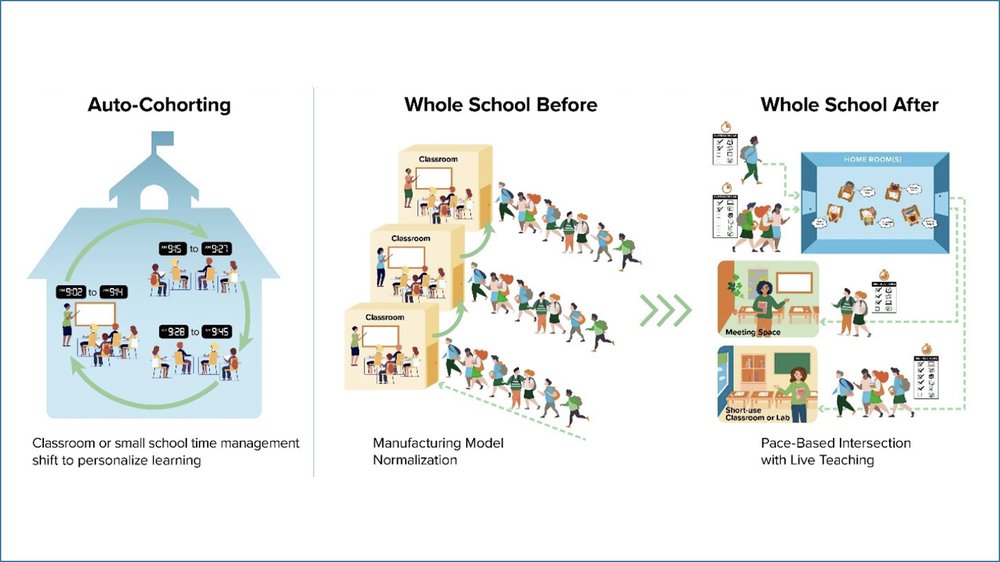Spatial-Temporal Artificial Intelligence (ST AI) is the ability to conceptualize the three-dimensional relationships of objects in space and to mentally manipulate them as a succession of transformations over a period of time.
Spatial temporal reasoning is what a person or a robot with artificial intelligence uses to understand how items fit together in a space. It is accomplished by picturing a spatial pattern, such as the way traditional schooling is a sort of manufacturing-line pattern of whole groups with one teacher in one classroom and movement to another classroom each hour. Spatial temporal reasoning includes visualizing a step-by-step process of how objects, such as how teachers and learners intersect, can be manipulated into different patterns over time.
This form of ST AI is about human logistics. It’s also known as Hybrid Logistics Schooling or Intelligent Calendaring. It is set to answer many problems in education including the teacher shortage and teacher overwhelm, attrition to alternative schooling, absenteeism, and low achievement.
Imagine wanting to deliver on truly personalized learning because that is what consumers really want and will shop around to find. The ultimate would be to have all your learners on individually paced courses, able to work at their own speed and at their level of cognition, but still having live classes or at least real interactions with teachers, still having a social togetherness with peers along the way. That would be true personalization because it would not inequitably normalize learners through how time is used on them as a member of a group only.
At issue is that schooling is mostly defined by a formality of whole-group classes which require students remain together at the same points in a course to learn subjects in the best sequence. Individually paced courses are asynchronous, meaning learners would typically be at sometimes wildly different points. Interjecting a whole-group class lecture on top of a course being individually paced, then, might be mis-timed and just add confusion for many in the course. Another approach could be to make all the live teaching moments, by design, not part of the sequence of asynchronous learning but supplemental and applicable at any point – an intellectual challenge to do in some and an impossibility in other subjects.
That is a problem for spatial-temporal reasoning. How can a class be scheduled when every learner is pacing independently? Some learners would be faster than others, a norm most educators are well acquainted with as they try to keep whole groups together. Others would be so slow in one subject, and maybe not in others, as to require a lot more teacher attention. One solution has been that self-paced learning by design is always asynchronous, done alone, with very little human teaching in the classic sense and little, if any, peer intersection. The well-known dichotomy between whole-group and individually paced learning is best seen in the chasm between all online elearning and traditional schooling. One is largely virtual and completely digital with little real human teaching interaction, and the other is almost entirely humanly distributed by voice and worksheets, and where the utility of digital is commonly an annoying administrative function for files and messaging with only a few discrete-function apps winning great acclaim.
Live human-teacher-led learning already distinguishes between in-class activities and homework. A mutation of live learning in a classroom is doing that same structure only via video conferencing to be virtually in a class – commonly what is thought of as “hybrid learning.”
Doing Both
The new concept called Hybrid Logistics Schooling is poised to solve personalized learning which still intersects with live teaching at scale – a new definition of “hybrid” that gets rid of old linear calendars and whole group classes. It depends on a lot of technology, but especially spatial-temporal AI, in this case used for an advanced form of intelligent calendaring with an ability to auto-cohort one meeting which has one purpose into multiples so that courses can be self-paced and accrue students at points that then trigger classes. While there is a lot of intelligent calendaring already available commercially, it was missing AI aspects necessary to schooling, particularly those that could cause asynchronous and synchronous learning to live together harmoniously. Such a hybrid took years to coalesce from observations of small-batch manufacturing, workflow logistics in shipping and transportation, and a lot of educator input. It then accelerated to take form during the pandemic with a real-life product.
Auto-Cohorting Floating Class Meetings
What was most necessary was the ability to have a meeting, like a single class, auto-cohort a whole group in a course into sub-sets, each sub-set having that class one at a time. Those meetings “float” until they accrue the full cohort. It would also have to coordinate space used dynamically without further human interference after the meeting is “released” and participants do the instructions written in the invitation before clicking “accept” to enroll in the subsequent meeting. The AI then awaits a full cohort accepting to set the first of multiple meetings.
What was also needed was to chain those meetings together as the synchronous moments between the asynchronous learning. Visualize this as a racetrack where learners are off racing away learning asynchronously but have pitstops along the way randomly. The AI watches for a cohort of various drivers needing a pitstop, a class with a teacher, and sets that. Then it watches for the next group of drivers and does the same class with the same teacher. Later a new series of pitstops, classes with other purposes, happen with random sub-groups of drivers in the race. Each would need to have a cohort number selected with the creation of the meeting and the length of time to be used, but no actual date and time because it would await achieving a full cohort and only then trigger to check all calendars and set a firm date and time automatically for that subset. If the cohort is not set too high, this would keep the faster students getting back on the racetrack for their next miles of asynchronous learning without a long wait.
The same pitstop class meeting would keep happening until all learners were through that one, with many already on to the next class long before the final set was done in the first class. If teachers were also not tethered to the same classroom while students were studying independently in homerooms or anywhere else racing along in their studies, the teacher could be roving to help students who need extra help or inspiration. The racing learners would disaggregate across time spans in any course, some just being calendared for class meeting five in some course while others are about to be calendared for meeting three. Teachers would find themselves holding more numerous, but often shorter, classes at different points in the course continuum, possibly on the same day.
The goal of schooling intelligent calendaring is to provide dynamic pace-based learning which still has live teaching intersection, but not always one-to-whole-group or one-on-one. With an AI handling the auto-cohorting and calendaring, teaching can remain largely as it’s always been traditionally in method. Teacher roles shift slightly in that they ideally do not have to do classroom management and a host of other duties unique to hosting a whole group all the time. Since the asynchronous part of lessons in courses would be auto-distributed and done anywhere, the act of live teaching in a class meeting is only the moment of purposeful engagement pre or post written instruction with their respective digital or paper resources. This might be orchestrated differently with very young students with the teacher still overseeing a whole group as is normal in kindergarten and primary grades.
Using ST AI for class meetings means teachers can still lecture, hold discussions, assess, do a science project or any hands-on activity, or just a quick check-in alongside steps in the course that they have marked with a “step” class meeting. Each class meeting may be designated a different cohort size, even down to one student if the school is small.
It is the live human togetherness that is preserved by ST AI in pace-based learning.
Again, the remarkable difference with ST AI in teaching is not method, but the use of teacher time and in which space a teaching moment occurs, such that the focus is on elevating teaching and not a host of other duties idiosyncratic to always being in a classroom. Teaching is now teaching. Discipline is on the shoulders of homeroom leaders or parents or the learner themselves, but with a balancing driver of self-pacing achievement and social groupings. The dynamics of challenging students and getting slower-pacing students to catch up can be managed by both faculty and schedules. Shifting schedules to give a student more time in any one subject is simple with ST AI. A slow student in one subject may be far ahead in another and their schedule adjusted to compensate.
The other difference is that the moment of teaching is now purposeful experiences, active human interactions. Teacher’s roles should shift to designing these poignant moments to be extra interactive to help create student agency through the asynchronous parts and also so that schools gain attraction as hubs of quality teaching.
How does it work?
While many people are now familiar with generative AI and search engine AI, they may not know a lot about spatial-temporal AI. It is most often associated with using big data sets and geo-location information to reach conclusions of, say, weather forecasting, shipping or geo-locating your Uber driver.
Knowstory, with eleven different patent claims applied for schooling ST AI, has built both a simple meeting-creation form and one that can “chain” meetings within a lesson sequencer to simulate a course having many class meetings. The meeting form itself can also act as a single lesson. In order to use the chaining aspects, users need to have a group in the platform, which can be a one-teacher-school, school or district. The system is built to link teachers with schools and with their districts in a tree-branching structure that also manages their inventory of curriculum from however many publishers and framework systems they use. This is so that master pacing calendars with unit creation can also overlay courses and class meeting creation. A planner allows a sequence of courses so that students can complete one and get the next one right away. A student’s achievements can be checked off and also analyzed against time to later make recommendations for additional learning and even career options.
Knowstory’s platform with spatial-temporal AI centers on meetings versus “classes” only but works with a new sort of block schedule if those are still used by a school.
To understand the heart of this form of spatial-temporal AI, the way Knowstory’s schooling calendar works is primarily through its meeting creation form as follows:
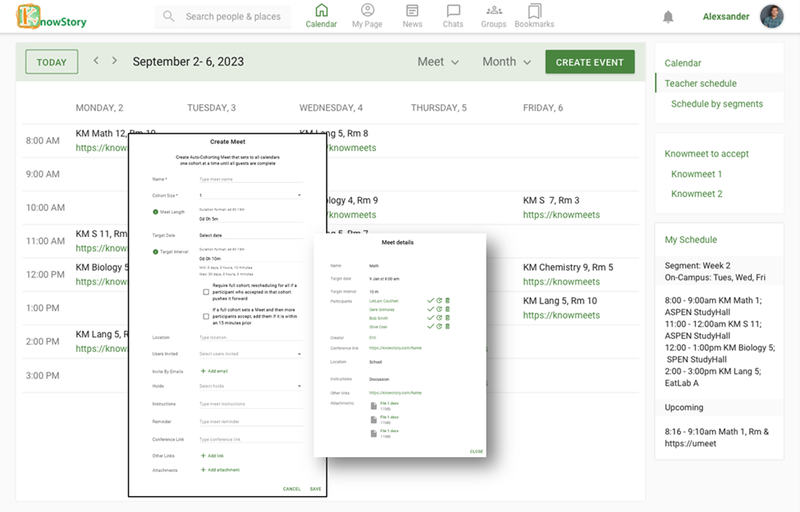
- Allow the meeting creator to designate the amount of time to be used at the actual meeting but does not require a specific date or time yet.
- Acceptance of the meeting uses AI calculations to select a settled date with no further human intervention.
- Meeting creators optionally select a cohort number that will divide the whole group of participants into sub-groupings from 1-100 participants each.
- The AI function of the form provides a method of auto-cohorting of those whole groups such that a single meeting set, like a class of old, would segment itself into cohorts as they accepted the meeting, becoming a “multi-meeting” by continuing to accrue and set date/time for each cohort until all participants are complete.
- Once released the meeting automatically adjudicates when to set each cohort meeting by reviewing each participant’s calendar in that subset and posting a time for all as calendar items, in tracking panels, and with notification messages.
- Meetings integrate to also appear on Microsoft Outlook or Google calendars.
- The form includes meeting labeling and a space for instructions, which are usually what to study prior to clicking acceptance of the meeting.
- The form includes election of the first target date and time so that invited participants know what they are aiming for, as to when to accept the meeting by if they complete instructions.
- The form includes selection of an “interval” that will automatically calculate the amount of time between the first target and a new, second target, and keep repeating the same interval to give new targets as the old one passes in time.
- The form includes a way to add web links and upload attachments.
- The form includes a way to select a physical space to be used, and a place to add-in a virtual video conferencing link.
- The form includes a text space to give the meeting maker a reminder of what to do in the actual meeting that no participants see.
- The form includes optionally marking the meeting to “require full cohort, rescheduling for all if a participant who accepted in that cohort pushes it forward,” which means that if a cohort fills and the meeting sets to calendars for that sub-group and then one or more of that sub-group pushes the meeting forward making it so that now the cohort is no longer full, the meeting deletes itself from all calendars and awaits a full cohort.
- The form includes marking the meeting such that “if a full cohort sets a Meet and then more participants accept, add them if it is within 15 minutes prior,” which means that after a cohort fills and a meeting is set firmly to the calendar and then more participants accept, they are added to go over the original cohort number. This is so that they do not have to wait for another cohort to be full.
- The form includes the addition of participants already in the system or inviting them by email address only.
- The form includes providing a meeting link after the form is saved complete so that it can be posted to outside systems. It advises that those outside systems have language telling users to click the link after they have completed work assigned. Clicking the link in an outside system is the same as “accepting” to enroll in the meeting.
- The system includes tracking panels which display to the meeting creator which participants have accepted, and to participants an ability to “accept,” “push forward” if they have already accepted, or “cancel” which does not necessarily remove them from the whole group of participants.
- The system includes a way to chain meetings like a course. Each different, each being able to be a multi-meeting breaking up into cohorts that calendar without further work by the teacher. In this way a course can have participants who are at different points in the sequence.
- The system provides a highly flexible way to build master schedules similar to earlier types with bracketing of the school year, segmenting of months, sectioning of weeks, rotations of days, and blocks and tracks for hours. These can be assigned to teachers and students. They are changeable down to the one person in the school group. Schedules are what the meetings would fall within and are part of meeting creation selections on the meeting form.
- For further customization of time, the system provides a way to label open-but-bracketed amounts of time with words like “Parent Conferences,” so that these can be checked and meetings for that subject or purpose can fall only inside those time frames once the AI goes to set them. Called “holds,” these timeframes can be across what might have been multiple units in several periods in former schedules, so that all units a teacher carries for a subject like 6th grade math can fall into what might have before been three or more hours of classes. Holds can have inside themselves “minus times” for breaks or lunch that meetings will not set over. This would be like having a Hold from 9:00am-1:30pm but minus a lunch break of 12:00pm-12:30pm and other smaller breaks. All meeting settings marked to use that hold would not use a block schedule or the default 8:00am-5:00pm to set itself. Holds are very useful for schools who are not using traditional master schedules but only a study schedule assigned to students.
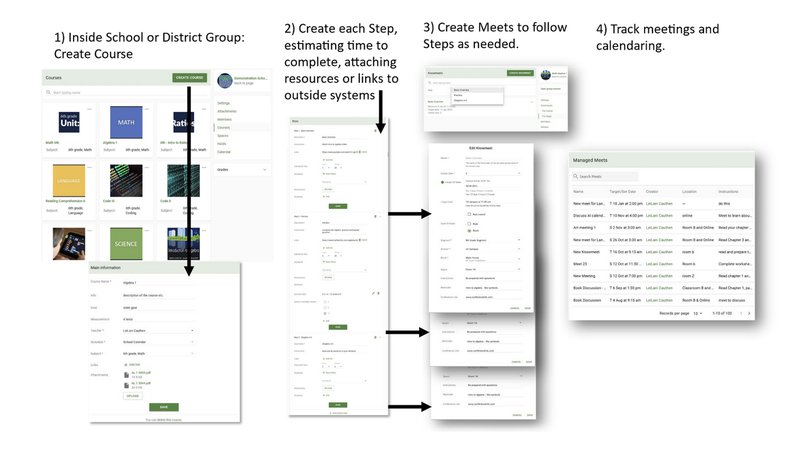
Schools sticking to their traditional block schedules can still use AI calendaring. It is advised though, that they build in “flex time” so that auto-cohorting meetings have more windows to calendar in. In fact, various schedules can use this form of AI in whole or in part for transforming their schooling or for professional development. The one most useful to know about is hybrid logistics schooling.
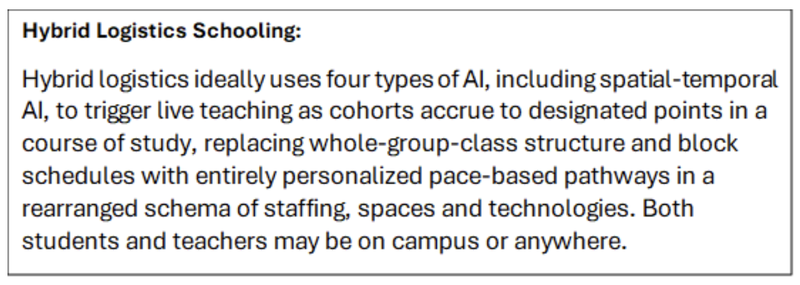
Below is a hybrid logistics schooling enterprise schema. Details of an institution’s full schema would need to have inventories of all technologies and additional considerations of their practical use in the workflow of live teaching and learning.
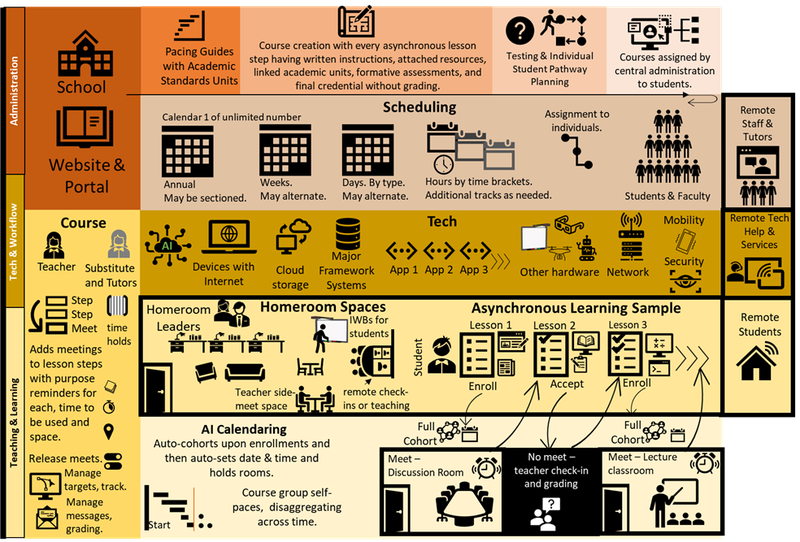
The following sample schema is another way to visualize the edtech stack and the interplay with learning pathways and space through spatial-temporal AI. In this schema, other AI may be in use such as recommendations engines within learning object repositories or as overlays. The same with generative AI and embedded AI which might be useful in large schools to track the new traffic patterns which are more randomized to find students quickly as to where they are at the moment.
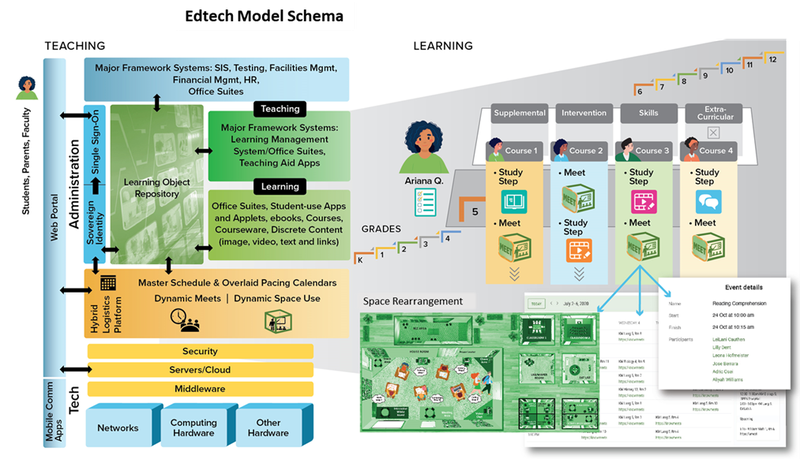
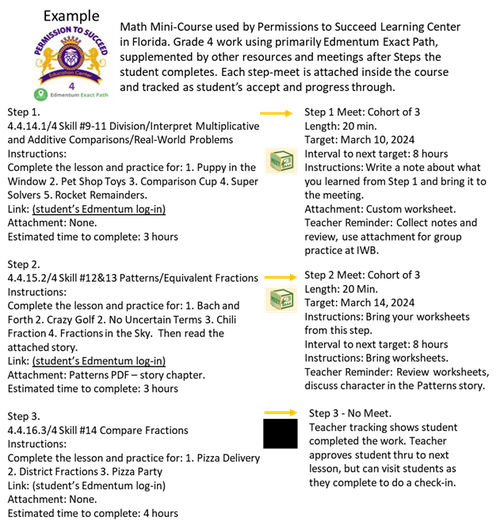
Here is also a small snapshot of one mini-course in use by Permissions to Succeed Learning Center in Florida. This one happens to use Edmentum Exact Path (eLearning) as its primary resource set, plotted into steps so that live meetings can occur at step points and supplemented by other resources as needed. Teachers can plan longer length meetings than this and any method including lecture, etc.
Guidance for exactly how Hybrid Logistics Schooling is to be done includes many elements to consider. One is the building of courses as either normally in length of several months or much shorter, more skills-based, or some combination of the two. Another consideration is the total numbers of students in any one course, which may now be the equivalent of three or more regular sized classes, and how large or small to set the cohort total so that calendars don’t “pack up” and neither fast or slow students are hindered, either by waiting too long for a full cohort so that a class triggers to set on the calendar or get little attention from teachers if they are slower because the teacher is in too many lecture-style class meetings.
Another consideration is the length of time in each class meet and if one is scheduled every day or not. Still another is the purpose of each class experience, and if those class experiences could possibly be cross-curricular, meaning involving multiple subjects in one experience. It is a certainty, that as ST AI merges with recommendations engines and generative AI, the likelihood of machines spotting when there is a convergence potential of subjects with a potential experience teaching both or all simultaneously, plus time, space, and participants across several courses, impressive results will be seen. The possibilities of true cross-curricular experiential learning have long evaded traditional schools because of all the logistics involved.
You can find out more about spatial-temporal AI as part of the Hybrid Logistics Project for a metamorphosis of schools and get help from experts through Learning Counsel’s Innovation Services.
Underwriters of the Hybrid Logistics Project include:
Strategic Vision Leadership Members:
Cisco Systems provides more than just network infrastructure for K-12 Schools. Cisco can help you build secure collaborative environments for enhanced safety, virtual learning systems, ubiquitous wireless connectivity, and more.
Varsity Tutors for Schools is a leading education solution provider, offering personalized one-to-one and small group high-dosage tutoring, 24/7 on-demand chat tutoring, and a range of robust learning resources. Trusted by over 250 schools and districts, our tailored offerings empower educational institutions to meet their goals for student success and family engagement. Explore our comprehensive solutions at:
Tactical Innovation Member:
Knowstory is the first schooling intelligent calendaring platform, relying on a form of spatial-temporal AI to help teaching and learning move to fully personalized pathways that are still human.
Contributing Member:
Carnegie Learning is a leading provider of K-12 education technology, curriculum, and professional learning solutions. For more than 25 years, we’ve channeled our leading research into tools and technology that champion teachers and build lifelong learners. Here’s to students who grow, classrooms that thrive, and teachers who succeed—today, tomorrow, and always.

